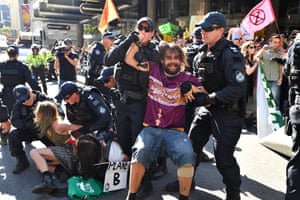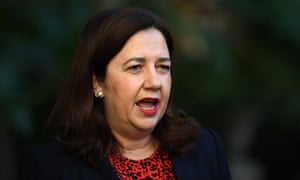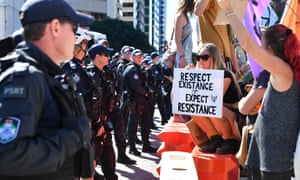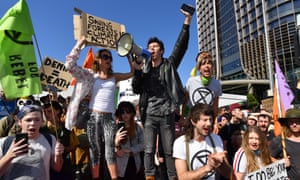The amorphous climate action group has fired up activists and opponents alike as it tries to shut down Brisbane
by Ben Smee
by Ben Smee
The
Extinction Rebellion protesters think you should be angry. They want
politicians and opinion columnists to be angry. The more people they
upset stopping traffic in the Brisbane city centre – the louder the car
horns, the more vicious the insults – the more certain it is they’ll be
back.
“It’s not an enjoyable experience, we don’t take pleasure in doing it,” says Emma Dorge, an activist arrested in Brisbane on Tuesday, during a day of mass civil disobedience that shut down Australia’s third-largest city.
“It is a polarising tactic. But this is an emergency, and we’re out of other options.”“It’s not an enjoyable experience, we don’t take pleasure in doing it,” says Emma Dorge, an activist arrested in Brisbane on Tuesday, during a day of mass civil disobedience that shut down Australia’s third-largest city.
Extinction Rebellion, the decentralised global movement calling for aggressive action on the climate crisis, has engaged in similar disruption tactics in major cities on every continent. Those protests have been most effective when they are most polarising, like in Queensland, where talking and writing and screaming and marching about the climate emergency has not shifted public sentiment; a state home to the threatened Great Barrier Reef, and also the world’s most controversial coal project.
Seventy-two people were arrested and charged by police during “rebellion day” protests in the heart of Brisbane on Tuesday. They have been stopping commuter traffic in the city for months. As outrage grows, so does the sense that climate change is finally subject of the anger it deserves.

“But shutting down central business districts of cities, if they can’t function anymore, if our cities are continually shut down and immobilised, that will force action. That’s what we’re building towards.
“These disruptions will only increase in frequency and duration. We’re not planning to stop until all of our demands are met.”
Clancey Maher was studying to be a nurse, working two jobs, when she headed north from Canberra about two years ago. Since then she has been involved in several anti-coal and climate protests.
“We are not kidding ourselves,” Maher says. “We’re not winning every person who gets stopped in a car. It’s necessary to force a reaction because the issue is so urgent.
“One of the key tactics is definitely disruption.
“You can ignore a petition, you can ignore a rally. This way it promotes public debate on the issue. If you weren’t already talking about climate change at the very least now you’re talking about the disruptions.”
A line in the sand
Extinction Rebellion’s global focus lends itself to actions in larger cities; pushing for the sorts of transformative changes that can be enacted by governments and corporations, the powerbrokers who might be caught in the commuter jams. About 1,000 people in have been involved in those various protests in Brisbane, with more than 100 arrested.At the same time, the movement runs in parallel to the work of dozens of coordinated environmental groups – some of which run conventional public campaigns and others engaging in blockades – that target the operations of prominent coal companies and their contractors. Many of the Extinction Rebellion protesters have converged on Brisbane while maintaining links to the direct action movement.
A day after the chaotic Extinction Rebellion protests in Brisbane, the group Frontline Action on Coal (Flac) issued a long-awaited “red alert” – a call for activists to head to central Queensland and to join physical efforts to stop Adani’s Carmichael coalmine.

For several years, Flac has maintained a camp at a rural property between Bowen and Collinsville; a potential base for launching protest activities at the Carmichael mine site, along the proposed rail route, or at the Abbot Point coal terminal. Flac expects potentially thousands to head north in response to its call.
“We need mass occupancy and mass amounts of people to stop this mine from going ahead,” says Amy, a Flac spokeswoman. “We’ve called the red alert because we now believe that it’s time for everyone to start mobilising and heading to central Queensland.
"It’s about getting those people who say they’re against Adani to physically get involved."
“It’s about getting people to understand that they now need to shift to playing a more active part in stopping [the Carmichael mine]. It’s about getting those people who say they’re against Adani to physically get involved and take part in direct action.”
As the company began land-clearing works on Wednesday, two Flac activists temporarily stopped about 17 bulldozers by suspending themselves from poles. They say attempts to stop work at Carmichael will continue and escalate.
Sophie, a midwife working in central Queensland, is one of many preparing to take a break from her job to take part in the protests.
“I feel like the next few months, the next few years are going to be super critical,” Sophie says. “I really love what I do but I want to ensure the kids I see every day being born are coming into a safe climate future.”
Police action called into question
As the disruptions in Brisbane become more frequent, the backlash has amped-up in volume and vitriol.In News Corp newspaper the Courier-Mail, protesters have been described variously as “ferals”, “ratbags”, “idiots”, “twerps”, “selfish, conceited, misguided … ideological zealots”, “unemployed thugs” and more.

The current Queensland premier, Annastacia Palaszczuk, has been more measured but called for the demonstrations to stop.
“When you stop people going to and from their workplace, I don’t think people like that,” Palaszczuk said.
The tactics of police have, during the past few weeks, become noticeably more direct.
At first, police resisted making mass arrests when protesters performed a “swarm”, blocking an intersection for up to 10 minutes. On Tuesday a young man was chased from the road by a police officer and tackled by a bystander. He broke his arm.
Police have also been accused of abusing their power by using bail conditions to punish protesters and shield corporate interests.
Fuelling the anger is the way the state crackdown on environmental protesters compares to its treatment of corporations who break environmental laws.
Last month, the Guardian revealed that a thermal coalmine in the Darling Downs region, New Acland, committed a “major” breach of the state’s environmental protection act by drilling 27 illegal bores. The company was fined $3,152.

“They want us to pay for our damages. The fossil fuel industry will never pay,” Wicks says. “It’s more about silencing activists, it’s deterring activists from doing these actions. At the end of the day the people in this movement know what’s at stake, and for that it’s worth losing our liberty and losing our money as well.”
‘We are society’
Protesters aged 18 to 73 were arrested in Brisbane on Tuesday. Hannah Doole is one of the younger ones. She finished school in 2017 and has since devoted her time to climate activism.“When you’re stopping traffic, people have to stop and think about what’s happening,” Doole says. “You’re not creating tension out of nothing, but you’re forcing it to the surface.
“The backlash, the dehumanising nature of it, I think it shows we’re gaining popularity and we’re gaining momentum and that’s gotten under the skin of the right wing.
“I am inspired by the diversity of people who have become involved, people who might be doing very respectable jobs, whether they’re scientists or working for the government.
“We’re not some group on the fringes of society. We are society.”
*First names only used at the request of those interviewed.

No comments:
Post a Comment